A
quick identification guide to the Land Rover Lightweight
Lightweight Military Half Ton 1968 - 1985
by Miles J. Murphy
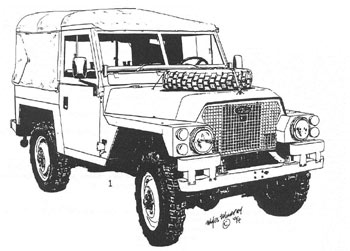
A
Lightweight prototype was tested in 1965. This vehicle was very
similar to production models. It had a unique bonnet and grille
arrangement. The layout was much the same as the early Series
IIA except the wire mesh grille was not an inverted "T". It was
more like the Series III, but the headlights protruded through,
somewhat reminiscent of the 1950 80". This grille was in two
sections, the upper third was actually part of the bonnet. The
split ran through the headlight center line. The military required
the vehicle to be re-designed in some areas. These changes raised
the weight of the vehicle above the 2,500 pound limit set by
the Ministry of Defense. The idea for a vehicle, light enough
to be carried by helicopter and fixed wing aircraft came about
in the 1950's.
The
British Royal marines were using Citroen 2CV pick-ups, flying
them ashore from their Commando ships slung beneath Westland "Whirlwind" helicopters.
The
standard military ¼ ton Land Rover was too heavy for
any helicopter then in service. The ¼ ton (88") and 3/4 ton
(109") were also too wide to be stored two abreast in the current,
and proposed new generation of transport aircraft. Oddly enough,
Series Ones (86" - 88") could be accommodated side by side when
some of these aircraft were proposed. When the Series II Land Rover
appeared in 1958 it was much wider than its predecessors. Lack
of forethought some might say, more a lack of communication would
be closer to the truth.
For
those interested, the Blackbury "Beverly" (4 radials/fixed
U/C and twin fins) and the Shorts "Belfast" (much like a C-130
- but bigger) were the backbone of the R.A.F. - heavy lift Transport
Command. The Armstrong Whitworth "Argosy" (known as the "Fly ing
Wheelbarrow") and the Hawker Siddeley "Andover" were in the medium
lift category. The "Argosy" was the main reason the Lightweight
ended up narrower than the standard Land Rover.
Getting Land Rovers to the war zone in a hurry wasn't a problem,
but moving them around the battlefield was a major priority.
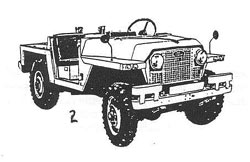 The
Lightweights ability to shed large portions of its upper body and
doors was the key to making it air-portable. Even so stripped,
the "Wessex" has
to dispense with a few sundry items to make the lift less of a strain.
Within a couple of years of the Lightweights introduction, more powerful
engines in the "Wessex", and the introduction of the Westland "Commando" and
Boeing CH-47 "Chinook" negated the need to remove body panels.
The
Lightweights ability to shed large portions of its upper body and
doors was the key to making it air-portable. Even so stripped,
the "Wessex" has
to dispense with a few sundry items to make the lift less of a strain.
Within a couple of years of the Lightweights introduction, more powerful
engines in the "Wessex", and the introduction of the Westland "Commando" and
Boeing CH-47 "Chinook" negated the need to remove body panels.
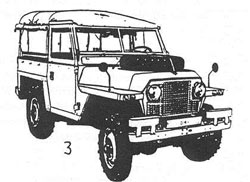 The need to strip
the Lightweight became obsolete, but the Lightweight remained in
production - with all of its easily removed panels until 1985.
The need to strip
the Lightweight became obsolete, but the Lightweight remained in
production - with all of its easily removed panels until 1985.
The
British Ministry of Defense (M.O.D.) placed the first order for
1,000 vehicles on August 31st 1967. Delivered from Solihull
began in 1968, but vehicles were put in storage and not released
for service until 1969. The first 1,400 built were Series I IA's
with headlights mounted on the radiator panel with an inverted "t" wire
mesh grille.
New
lighting regulations in many countries where the Lightweight
was expected to see service resulted in the relocation of the
lights to redesigned wings. This change also occurred on civilian
and standard military ¼ ton
and 3/4 ton Land Rovers.
Vehicles
with this new configuration (plus other cosmetic changes) are
usually referred to as "late" IIA's.
In all, about 3,000 Series IIA's were built. The Series III Land
Rovers were launched in mid 1971, but due to outstanding orders
for IIA Lightweights, the Series III version did not appear until
1972. Externally, the only way to distinguish a Late IIA lightweight
from a Series III are the windscreen hinge/bracket. Apart from
aa full synchromesh gearbox, the relocation of the ignition key
to the steering column, that was it. The next changes occurred
in the late 1970's and early 1980's. They were, extra rear lights,
larger sidelight and indicator lenses and the deletion of bumper
overriders (on some, but not all). Of course, there were all sorts
of changes under the hood but we're not going to get into that
here. Series III production is in excess of 14,000. Just about
all Lightweights have been withdrawn from military service. Standard
military 90's and 110's have rep laced them. There are believed
to be at least 50 examples of the lightweight in North America.
They include early and Late IIA's and Series III's. Late IIA's
and Series III's.
What's
in a name? When first conceived, the Lightweight was referred
to - in official circles - as the "Rover 1". Its official military
designation was "Half Ton". And, obviously, as everyone calls it
Lightweight, that's its most common name.
Some
refer to it as the "Airportable", but this was a name given
to a special version of the 109". Airportable 109" could be stacked
3 high for airporting. I5t also has a special body, not only to
accommodate stacking, but making it amphibious. With a p.t.o. driven
propeller, pontoons and steering provided by the front wheels the
airportable could take to water like a duck.
Lightweights
are sometimes called "Cutwings". This is a common
name for Australian and New Zealand Series IIA 88's and 109"'s. The
front wheel arches are angular rather that the familiar curve (similar
to, but not exactly like the Santana Ligero/Militar ). The rest of
the antipodian Rover was standard body. Several people call the lightweight
the "airdrop". The only problem with the name is, every Land Rover
has been dropped as well.
Spanish Lightweight
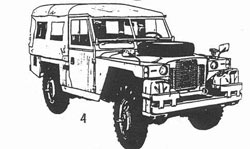
Spain
was perhaps the second largest manufacturer of Land Rovers. Production
commenced with the Series II in 1958. The II was followed by the
IIA and III in 88" and 109" form. Metalurgica de Santa Ana
- or Santana - developed their own version of the 1 09" in Forward
Control (F.C.) form. They also took the British FC 101 a step
further calling their civilian version the Santana 2000. The
familiar Series III's began to take on a hispanic look all of
their own. The Series IIA took the leaf sprung Rover a step further
as did the 110 look-a-like (albeit with leaf springs) Series
IV.
In the late
1970's Santana launched military versions of their 88 and 109.
Named "Militar", these Rovers followed
the same concept as the British Lightweight. As helicopters in
Spanish service were capable weight lifters, there was no great
need to make the bodywork demountable. With no transport aircraft
capable of carrying Militars two abreast there was no great need
to make the 88's and 109's narrower. The design of the Spanish
Militar probably had more to do with making the Land Rover a bit
more menacing. A civilian version of the Militar was launched
by Santana in 1980. It bears the name "Ligero" which
is Spanish for Lightweight.
Iranian Lightweight
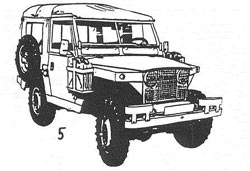
Santana
played a major role developing the Iranian Land Rover connection.
In their factory at Farsi the Iranian company Morattab assembled
a full line of 88's and 109's. Major components arrived from
Spain as Completely Knocked Down (CKD) kits. By the l ate 1980's,
at least 75% of the components going into the completed vehicles
were of local origin. Just as Santana became independent from Solihull,
so to did the Iranians become from Spain. The Iranian Lightweight,
although bearing a strong similarity to the Ligero/Militar was
reported to be of 100% local origin (a Chinese copy).
The Australians have a lightweight version of their 6x6 110. Even
though its referred to as a lightweight, it has nothing in common
with the British, Spanish and Iranian vehicles.
The information printed here is not Gospel, but its damn close...
Miles J. Murphy Oct 1994
Next Issue:- Series One 1948 - 1953
Reprinted from the OVLR Newsletter, December, 1994 


















